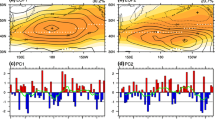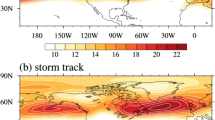Abstract
Analysis of NCEP-NCAR I reanalysis data of 1948–2009 and ECMWF ERA-40 reanalysis data of 1958–2001 reveals several significant interdecadal changes in the storm track activity and mean flow-transient eddy interaction in the extratropics of Northern Hemisphere. First, the most remarkable transition in the North Pacific storm track (PST) and the North Atlantic storm track (AST) activities during the boreal cold season (from November to March) occurred around early-to-mid 1970s with the characteristics of global intensification that has been noticed in previous studies. Second, the PST activity in midwinter underwent decadal change from a weak regime in the early 1980s to a strong regime in the late 1980s. Third, during recent decade, the PST intensity has been enhanced in early spring whereas the AST intensity has been weakened in midwinter. Finally, interdecadal change has been also noted in the relationship between the PST and AST activities and between the storm track activity and climate indices. The variability of storm track activity is well correlated with the Pacific Decadal Oscillation and North Atlantic Oscillation prior to the early 1980s, but this relationship has disappeared afterward and a significant linkage between the PST and AST activity has also been decoupled. For a better understanding of the mid-1970s’ shift in storm track activity and mean flow-transient eddy interaction, further investigation is made by analyzing local barotropic and baroclinic energetics. The intensification of global storm track activity after the mid-1970s is mainly associated with the enhancement of mean meridional temperature gradient resulting in favorable condition for baroclinic eddy growth. Consistent with the change in storm track activity, the baroclinic energy conversion is significantly increased in the North Pacific and North Atlantic. The intensification of the PST and AST activity, in turn, helps to reinforce the changes in the middle-to-upper tropospheric circulation but acts to interfere with the changes in the low-tropospheric temperature field.












Similar content being viewed by others
References
Baldwin MP, Dunkerton TJ (2001) Stratospheric harbingers of anomalous weather regimes. Science 244:581–584
Blackmon ML (1976) A climatological spectral study of the 500 mb geopotential height of the northern hemisphere. J Atmos Sci 33:1607–1623
Blackmon ML, Wallace JM, Lau NC, Mullen SL (1977) An observational study of the northern hemisphere wintertime circulation. J Atmos Sci 34:1040–1053
Cai M, Mak M (1990) On the basic dynamics of regional cyclogenesis. J Atmos Sci 47:1417–1442
Cai M, Yang S, Van den Dool HM, Kousky VE (2007) Dynamical implications of the orientation of atmospheric eddies: a local energetics perspective. Tellus 59A:127–140
Castanheira JM, Graf HF (2003) North Pacific-North Atlantic relationships under stratospheric control? J Geophys Res 108:4036. doi:10.1029/2002JD002754
Chang EKM (2004) Are the northern hemisphere winter storm tracks significantly correlated? J Clim 17:4230–4244
Chang EKM, Fu Y (2002) Interdecadal variations in northern hemisphere winter storm track intensity. J Clim 15:642–658
Chang EKM, Fu Y (2003) Using mean flow change as a proxy to infer interdecadal storm track variability. J Clim 16:2178–2196
Chang EKM, Lee S, Swanson KL (2002) Storm track dynamics. J Clim 15:2163–2183
Chen TC, Yoon JH (2002) Interdecadal variation of the North Pacific wintertime blocking. Mon Weather Rev 130:3136–3143
Dole RM, Black RX (1990) Life cycles of persistent anomalies. Part II: the development of persistent negative height anomalies over the North Pacific Ocean. Mon Weather Rev 118:824–846
Eichler T, Higgins W (2006) Climatology and ENSO-related variability of North American extratropical cyclone activity. J Clim 19:2076–2093
Hare SHE, James IN (2001) Baroclinic developments in jet entrances and exits. I: linear normal modes. Q J R Meteorol Soc 127:1293–1303
Harnik N, Chang EKM (2003) Storm track variations as seen in radiosonde observations and reanalysis data. J Clim 16:480–495
Honda M, Nakamura H (2001) Interannual seesaw between the Aleutian and Icelandic lows. Part II: its significance in the interannual variability over the wintertime northern hemisphere. J Clim 14:4512–4529
Honda M, Nakamura H, Ukita J, Kousaka I, Takeuchi K (2001) Interannual seesaw between the Aleutian and Icelandic lows. Part I: seasonal dependence and life cycle. J Clim 14:1029–1042
Honda M, Yamane S, Nakamura H (2005) Impacts of the Aleutian-Icelandic low seesaw on surface climate during the twentieth century. J Clim 18:2793–2802
Hoskins BJ, Valdes PJ (1990) On the existence of storm tracks. J Atmos Sci 47:1854–1864
Jin FF (2010) Eddy-Induced instability for low-frequency variability. J Atmos Sci 67:1947–1964
Kalnay E et al (1996) The NCEP/NCAR 40-Year reanalysis project. Bull Am Meteor Soc 77:437–471
Kug JS, Jin FF, Par JH, Ren HL, Kang IS (2010) A general rule for synoptic-eddy feedback onto low-frequency flow. Clim Dyn 35:1011–1026
Latif M, Barnett TP (1994) Causes of decadal climate variability over the North Pacific and North America sector. Science 266:634–637
Lau NC (1988) Variability of the observed midlatitude storm tracks in relation to low-frequency changes in the circulation patterns. J Atmos Sci 45:2718–2743
Lee S (2000) Barotropic effects on atmospheric storm tracks. J Atmos Sci 57:1420–1435
Lee SS, Lee JY, Wang B, Jin FF, Lee WJ, Ha KJ (2011) A comparison of climatological subseasonal variations in the wintertime storm track activity between the North Pacific and Atlantic: local energetics and moisture effect. Clim Dyn. Published online doi:10.1007/s00382-011-1027-z
Lindzen RS, Farrell BJ (1980) A simple approximate result for the maximum growth rate of baroclinic instabilities. J Atmos Sci 37:1648–1654
Mak M, Deng Y (2007) Diagnostic and dynamical analyses of two outstanding aspects of storm tracks. Dyn Atmos Oceans 43:80–99
Nakamura H (1992) Midwinter suppression of baroclinic wave activity in the Pacific. J Atmos Sci 49:1629–1642
Nakamura H, Shimpo A (2004) Seasonal variations in the southern hemisphere storm tracks and jet streams as revealed in a reanalysis dataset. J Clim 17:1828–1844
Nakamura H, Izumi T, Sampe T (2002) Interannual and decadal modulations recently observed in the Pacific storm track activity and East Asian winter monsoon. J Clim 15:1855–1874
Nie J, Wang P, Yang W, Tan B (2008) Northern hemisphere storm tracks in strong AO anomaly winters. Atmos Sci Let 9:153–159
Nonaka M, Nakamura H, Taguchi B, Komori N, Yoshida-Kuwano A, Takaya K (2009) Air-sea heat exchanges characteristic to a prominent midlatitude oceanic front in the South Indian Ocean as simulated in a high-resolution coupled GCM. J Clim 22:6515–6535
Orsolini YJ, Kvamstø NG, Kindem IT, Honda M, Nakamura H (2008) Influence of the Aleutian-Icelandic low seesaw and ENSO onto the Stratosphere in ensemble winter hindcasts. J Meteorol Soc Jpn 86:817–825
Penny S, Gerard HR, David SB (2010) The source of the midwinter suppression in storminess over the North Pacific. J Clim 23:634–648
Pinto JG, Reyers M, Ulbrich U (2011) The variable link between PNA and NAO in observations and in multi-century CGCM simulations. Clim Dyn 36:337–354
Raible CC, Luksch U, Fraedrich K, Voss R (2001) North Atlantic decadal regimes in a coupled GCM simulation. Clim Dyn 18:321–330
Rivière G, Orlanski I (2007) Characteristics of the Atlantic storm-track eddy activity and its relation with the North Atlantic Oscillation. J Atmos Sci 64:241–266
Sampe T, Nakamura H, Goto A, Ohfuchi W (2010) Significance of a midlatitude SST frontal zone in the formation of a storm track and an eddy-driven westerly jet. J Clim 23:1793–1814
Straus DM, Shukla J (1997) Variations of midlatitude transient dynamics associated with ENSO. J Atmos Sci 54:777–790
Taguchi B, Nakamura H, Nonaka M, Xie SP (2009) Influences of the Kuroshio/Oyashio extensions on air–sea heat exchanges and storm-track activity as revealed in regional atmospheric model simulations for the 2003/04 cold season. J Clim 22:6536–6560
Tomita H, Kubota M (2005) Increase in turbulent heat flux during the 1990s over the Kuroshio/Oyashio extension region. Geophys Res Lett 32:L09705. doi:10.1029/2004GL022075
Trenberth KE (1990) Recent observed interdecadal climate changes in the northern hemisphere. Bull Am Meteor Soc 71:988–993
Trenberth KE, Hurrell JW (1994) Decadal atmosphere-ocean variations in the Pacific. Clim Dyn 9:303–319
Uppala SM et al (2005) The ERA-40 re-analysis. Q J R Meteorol Soc 131:2961–3012
van Loon H, Rogers JC (1978) The seesaw in winter temperatures between Greenland and Northern Europe. Part I: general description. Mon Weather Rev 106:296–310
Wang B, Barcilon A (1986) Moist stability of a baroclinic zonal flow with conditionally unstable stratification. J Atmos Sci 43:705–719
Woollings T, Hannachi A, Hoskins B (2010) Variability of the North Atlantic eddy-driven jet stream. Q J R Meteorol Soc 136:856–868
Yonetani T, McCabe GJ (1994) Abrupt changes in regional temperature in the conterminous United States. Clim Res 4:12–23
Zhang Y, Held IM (1999) A linear stochastic model of a GCM’s midlatitude storm tracks. J Atmos Sci 56:3416–3435
Zhang R, Li G, Fan J, Wu DL, Molina MJ (2007) Intensification of Pacific storm track linked to Asian pollution. Proc Nat Acad Sci 104:5295–5299
Zhu W, Sun Z (1999) Influence of ENSO event on the maintenance of Pacific storm track in the Northern winter. Adv Atmos Sci 16:630–640
Acknowledgments
This work was supported by the Global Research Laboratory (GRL) Program from the Ministry of Education, Science and Technology (MEST), Korea. J.-Y. Lee and B. Wang acknowledge support from the Korean Meteorological Administration Research and Development Program under Grant RACS 2010–2017 and from International Pacific Research Center, which is in part supported by JAMSTEC, NOAA, and NASA. This is SOEST publication number 8483 and IPRC publication number 817.
Author information
Authors and Affiliations
Corresponding author
Appendix
Appendix
1.1 Barotropic and baroclinic energy conversion
The barotropic energy conversion (BTEC) can be expressed by the inner product of the D-vector of the basic flow and the E-vector of the transient parts (Cai et al. 2007). The D-vector defined as \( {\vec{\text{D}}} = \left( {\frac{{\partial {\bar{\text{u}}}}}{{\partial {\text{x}}}} - \frac{{\partial {\bar{\text{v}}}}}{{\partial {\text{y}}}},\frac{{\partial {\bar{\text{v}}}}}{{\partial {\text{x}}}} + \frac{{\partial {\bar{\text{u}}}}}{{\partial {\text{y}}}}} \right) \) consists of the stretching and shearing deformations. The E-vector defined as \( {\vec{\text{E}}} = \left( {\frac{1}{2}\left( {\overline{{{\text{v}}^{\prime 2} }} - \overline{{{\text{u}}^{\prime 2} }} } \right), - \overline{{{\text{u}}^{\prime } {\text{v}}^{\prime } }} } \right) \) is a measure of the local shape and horizontal orientation of eddies (Cai and Mak 1990).
where, g is the acceleration of gravity and p0 is 1,000 hPa. The overbar and prime represent the climatological mean and transient parts, respectively.
The baroclinic generation from mean available potential energy to eddy available potential energy (BCEC I) is roughly proportional to the poleward eddy heat flux multiplied by the meridional temperature gradient (Dole and Black 1990; Cai et al. 2007).
where, R is the gas constant for dry air and CP (CV) is the specific heat of dry air at the constant pressure (volume). Θ indicates potential temperature.
The energy conversion between eddy available potential energy and eddy kinetic energy (BCEC II) can be expressed by upward heat flux (Dole and Black 1990; Cai et al. 2007)
1.2 Eddy feedback
The geopotential height and temperature tendency from eddy feedback are calculated by vorticity and heat flux convergences of the transient eddies according to Cai et al. (2007)
1.3 Lepage test statistic
The Lepage test statistic is a useful tool for detecting significant changes between two samples (Yonetani and McCabe 1994). Using the Lepage test, we can detect changes in the mean and in the variance of variable through time. The Lepage test statistic is calculated as follow.
where, n1 and n2 are sample sizes of samples a and b respectively. The N is sum of n1 and n2. The ui = 1 when the ith record in a combined sample of ranked values of samples a and b belongs to the sample a, and ui = 0 when it belongs to the sample b. If the Lepage test statistic is greater than 5.99 (9.21), the change between two samples is significant at a 95% (99%) confidence level. Details of Lepage test are described in Yonetani and McCabe (1994).
Rights and permissions
About this article
Cite this article
Lee, SS., Lee, JY., Wang, B. et al. Interdecadal changes in the storm track activity over the North Pacific and North Atlantic. Clim Dyn 39, 313–327 (2012). https://doi.org/10.1007/s00382-011-1188-9
Received:
Accepted:
Published:
Issue Date:
DOI: https://doi.org/10.1007/s00382-011-1188-9




